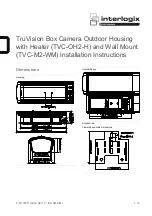
29
s
You can display the pictures without being rotated when [ROTATE DISP.] is set to [OFF].
s
You can rotate pictures with the [ROTATE] function.
s
You can only display the pictures rotated if you use a lens that supports the direction
detection function and [ROTATE DISP.] is set to [ON].
s
Did you press [
]?
s
Is the card inserted?
s
Is there a picture on the card?
s
Is this a picture whose file name has been changed in the PC? If it is, it cannot be played back
by this unit.
s
Has [PLAYBACK MODE] been set for playback?
Change to [NORMAL PLAY].
s
Is this a non-standard picture, a picture which has been edited using a PC or a picture which
was taken by another make of digital camera?
s
Did you remove the battery immediately after picture-taking or did you take the picture using a
battery with a low remaining charge?
Format the data to delete the pictures mentioned above.
(Other pictures will be deleted as well and it will not be possible to restore them.
Therefore, check well before formatting.)
Playback
The picture being played back is not rotated, or is rotated in an unexpected
direction, when displayed.
The picture is not played back.
The recorded pictures are not displayed.
The folder number and the file number are displayed as [—] and the screen turns
black.
s
Is the clock in the camera set properly?
s
Images edited on a PC or images recorded on other cameras might display a different date to
the recorded date during the Calendar Playback.
s
Is it a picture that has been recorded with other equipment? In such cases, these pictures may
be displayed with a deteriorated picture quality.
s
When the flash is set to red-eye reduction ([
], [
], [
]) and if you take a picture of
subject with red color surrounded by a skin tone color, that red part may be corrected to black
by the digital red-eye reduction function.
It is recommended to take pictures with the [D.RED-EYE] set to [OFF].
s
This unit automatically adjusts the aperture during motion picture recording. A clicking sound
may occur at this time depending on the lens, and this sound may be recorded on the motion
pictures. This is not a malfunction.
s
The operational sound of the zoom or button operation may be recorded when it is operated
during the recording of a motion picture.
Images with different date as recorded date are played back in the Calendar
Playback.
White round spots like soap bubbles appear on the recorded picture.
s
If you take a picture with the flash in a dark place or indoors, white round
spots may appear on the picture caused by the flash reflecting of particles of
dust in the air. This is not a malfunction.
A characteristic of this is that the number of round spots and their position
differ in every picture.
[THUMBNAIL IS DISPLAYED] appears on the screen.
Red part of the recorded image has changed color to black.
A clicking sound is recorded in the motion pictures.
Содержание Lumix DMC-GH1KPP
Страница 15: ...15 4 Specifications...
Страница 34: ...34 7 Troubleshooting Guide...
Страница 35: ...35...
Страница 36: ...36...
Страница 37: ...37...
Страница 41: ...41 9 Disassembly and Assembly Instructions 9 1 Disassembly Flow Chart 9 2 PCB Location...
Страница 43: ...43 9 3 1 Removal of the Rear Case Unit Fig D1 Fig D2...
Страница 44: ...44 9 3 2 Removal of the Top Case Unit Fig D3 9 3 3 Removal of the LVF Unit Fig D4...
Страница 46: ...46 Fig D8 9 3 7 Removal of the Battery Case Unit Fig D9 9 3 8 Removal of the Speaker and DC Cover Fig D10...
Страница 47: ...47 Fig D11 9 3 9 Removal of the Flash P C B Fig D12 Fig D13 9 3 10 Removal of the Flash Sub P C B Unit Fig D14...
Страница 48: ...48 Fig D15 9 3 11 Removal of the AF Assist P C B EXT MIC P C B and Remote P C B Fig D16...
Страница 49: ...49 Fig D17 9 3 12 Removal of the Optical Sensor Unit Fig D18 9 3 13 Removal of the LCD Unit Fig D19...
Страница 50: ...50 Fig D20 9 3 14 Removal of the LCD TFT Unit Fig D21...
Страница 51: ...51 9 3 15 Removal of the Mic P C B and Mic Unit Fig D22 Fig D23...
Страница 54: ...54...
Страница 56: ...56 There are no LCD LVF adjustment model...
















































